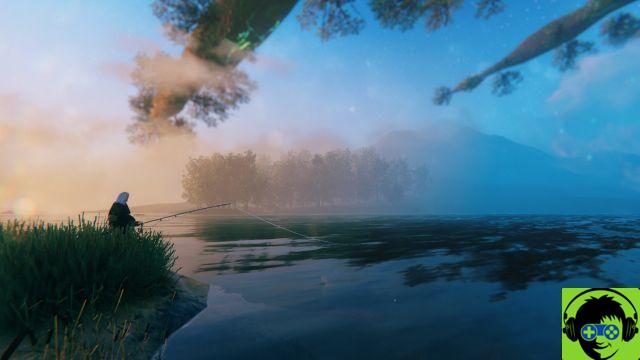
American black bear
The American black bear is found in the remote forests of Roanoke, Big Valley, and Tall Trees. He is smaller than the grizzly. The main diet of these omnivorous animals consists of salmon, honey, fruits, small mammals and carrion. Several shots of sedative are needed to penetrate its thick fur.
- Can be found in tall trees or upstream of the Little Creek River.
North American Beaver
The North American beaver is found along the Kamassa River in Roanoke. Its herbivorous diet consists of tree bark, cambium, roots, buds and aquatic plants. Beavers need very few sedatives.
- Can be found along the Upper Montana River just below the Owanjila Dam, or the Kamassa River below the Elysian Pool.
North American raccoon
North American raccoons are found in Lemoyne, New Hanover, and West Elizabeth. As omnivores, their diet includes plants, berries, amphibians, rodents, and eggs, depending on their environment. Only a few shots of sedatives are needed.
- Found around Strawberry or in the vicinity of Riggs Station.
American red fox
The American red fox is native to the forests and prairies of West Elizabeth, New Hanover and Lemoyne. As omnivores, their diet consists of small mammals like squirrels and rabbits, as well as birds, fruits, berries, and herbs. A few shots of sedative will make this fox unconscious.
- Found around Strawberry or Emerald Station.
American gray fox
The American Gray Fox is native to the forests and prairies of West Elizabeth, New Hanover and Lemoyne. As omnivores, their diet consists of small mammals like squirrels and rabbits, as well as birds, fruits, berries, and herbs. Foxes can be easily sedated with just a few injections.
- Also found around Strawberry and Emerald Station, or you can also look near Van Horn Trading Post.
Silver fox
The silver fox can be found in various habitats across the states. They are omnivores, feeding on plant matter, rodents, insects, birds and carrion. This fox will only need a small number of sedating shots.
- And again, found in the same places as American red and gray foxes.
Striped skunk
The striped skunk can be found in a variety of habitats across the states. Their omnivorous diet consists of insects, fish, crustaceans, small mammals, grasses, fruits and carrion. Skunks have the ability to create a spray using their scent glands to deter predators. Due to their size, only a small amount of sedative is needed to bring a skunk under control.
- Found near Riggs Station or northwest of Lemoyne.
Virginia Opossum
The Virginia Opossum can be found in a variety of habitats across the states. As omnivores, their diet consists of grains, nuts, fruits, amphibians, birds and their eggs, mice and carrion. Very little sedation is needed.
- Can also be found near Riggs Station or northwest of Lemoyne.
American muskrat
The primary habitat of the American muskrat is found along the rivers and shores of New Austin, West Elizabeth, Lemoyne, and New Hanover. As omnivores, their diet consists of aquatic vegetation, small fish, and amphibians. This rodent needs a small dose of sedative.
- Along the Dakota River and Blue Water Marsh. Keep in mind that these are small creatures, so you will probably have to use your eagle eye to spot them.
Western Bull Moose
The Western Bull Moose originates from the state of West Elizabeth. Their omnivorous diet includes willow and birch shoots, aquatic plants, and herbaceous plants. These large mammals require several injections of the sedative before they can be safely collected.
- Look for them near Owanjila or around the northern tip of the Roanoke Valley. I had to reappear in several different lobbies before I could find a single one.
Western moose
Western moose are found in the remote woodlands of West Elizabeth, Ambarino, and New Hanover. Their omnivorous diet includes willow and birch shoots, aquatic plants, and herbaceous plants. Use a heavy dose of sedative to bring this mammal down.
- Found in the same places as the Western Bull Moose. It will probably take you some time to find one as well, so be prepared.
Grizzly
Grizzly bears are endemic to Grizzlies East. As an omnivore, its diet ranges from berries, roots, and grasses to deer, elk, fish, and carrion. Be warned, a large amount of sedative is needed to safely control a grizzly bear.
- It's mostly found in Grizzlies East, or you can watch along the Little Creek River near Wallace Station.
Black tailed jackrabbit
The black-tailed hare can be found in a variety of habitats across the states. As herbivores, their diet consists of plant plants, buds, twigs, bark and crops, which is why they are considered to be pests. Use only a few shots of sedatives on these creatures.
- Literally found everywhere, but you can specifically look around The Heartlands.
Also…
If you're looking for the fastest way to level up, you'll want to try and grow the maximum number of samples from each animal before moving on to the next. Once you've captured the maximum number of samples for each of the animals, return to Harriet and flip them one at a time to receive the corresponding stamp in your Animal Grounds Guide. Once you have all of the buffers in the Farmland Habitat set, redeem them for 1000 XP for the Naturalist role. Repeat this same process four more times until you have successfully returned all of your samples. This should get you 5000 XP in total, bringing you that much closer to becoming a Distinguished Naturalist.


























